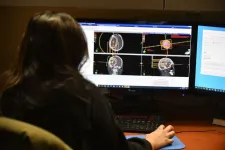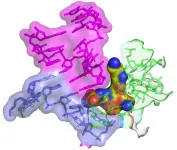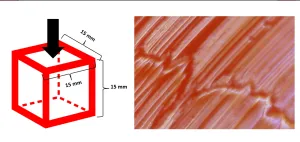(Press-News.org) Online workflow systems for off-site radiologists are one reason for health care delays that cost hospitals money and test the patience of patients, according to West Virginia University research.
Bernardo Quiroga, associate professor of supply chain management at the WVU John Chambers College of Business and Economics, and his coauthors analyzed a radiology workflow platform, used by thousands of U.S. hospitals, which allows radiologists working from home to log in, view a pool of tasks such as X-rays or CT and MRI scans that are available for processing, and choose which of those radiological studies to read and report on.
The radiologists’ choices were based on the studies’ priority levels and what they perceived each study’s ratio of pay-to-workload to be — “how financially attractive the job is relative to the labor involved, or the job’s ‘bang for the buck,’” Quiroga said.
The researchers found radiologists chose to work on lower-priority studies offering more bang for the buck when higher-priority studies with less bang for the buck were available — choices that, in aggregate, led to delays for higher-priority cases. Their findings are in the Journal of Operations Management.
Quiroga emphasized the data doesn’t suggest radiologists are putting medically urgent scans on the back burner. They tend to neglect studies with medium-level “administrative” and “operational” priorities, not studies with high clinical priority.
Even so, the longer turnaround times created by this kind of poorly calibrated compensation scheme can delay results and patient admissions.
“Hospitals accrue direct costs by not having results available as soon as possible,” Quiroga said. “However, the significant patient dissatisfaction that also arises from that delay is especially pertinent under Medicare’s Value-Based Purchasing Program, which makes patient satisfaction scores critical to hospitals’ revenues.”
Remote radiologists have been around for decades. Providers send scans off-site to get time-sensitive images processed overnight or to fill gaps at short-staffed rural hospitals.
While radiologists working in hospitals are typically salaried, Quiroga explained those working remotely often earn money via a “piece-rate compensation scheme, in which they’re paid for each task regardless of how long it takes. Piece-rate compensation can be good for worker productivity and worker earnings – but only if the scheme is set up correctly. Determining the right rate for a job can be a tricky task with serious negative repercussions if mishandled.”
Radiologists whose compensation is piece-rate typically meet annual productivity targets, with bonuses for exceeding those targets. The amount a radiologist can earn from each study is expressed in terms of an RVU, or “relative value unit.” That’s a reimbursement amount set by the Centers for Medicare and Medicaid Services; the value of one RVU in 2022 was $33.59.
“In recent years, a strong drive towards evaluating radiologists’ efficiency in terms of their daily RVU output has generated considerable criticism from the radiology community, which says those metrics lead to an unhealthy work environment and increase mistakes,” Quiroga said. “On top of that, imbalances between Medicare and Medicaid pay rates for tasks performed and the actual workloads involved in those tasks have been the subject of extensive discussion within the medical community and especially radiology.
“This research provides evidence that an intense focus on productivity as driven by the RVU may have unintended negative consequences on the level of service radiologists provide to hospitals — and ultimately to patients.”
The dataset for the research comprised more than 2.1 million studies spanning 251 procedures from 62 hospitals, read by 115 radiologists. The hospitals had assigned each study a priority, ranging from “hyperacute,” requiring immediate attention because a patient’s life was in danger, to “routine,” indicating no urgency.
“The two priority levels between ‘hyperacute’ and ‘routine’ are ‘stat’ and ‘expedited,’” Quiroga said. “Almost two-thirds of our database was stat studies: conditions that are medically acute but not life-threatening. Once all hyperacute studies have been completed, stat studies need to be read ASAP.”
On the other hand, expedited studies, like routine ones, have the lowest clinical urgency. They do have operational urgency, though. If a patient is waiting on radiology in order to be discharged, their study might be prioritized as expedited because another patient needs the bed.
“We discovered that the expedited priority class contained the highest percentage of delayed studies, and those delays could be quite large,” Quiroga said. “The workflow platform provider is contractually bound to achieve a certain level of turnaround time, so delay is an important performance measure.”
The root of the problem within the radiology workflow platform driving these delays is likely badly calculated RVUs that don’t reflect the real time and effort tasks take. But realigning that system would be so costly that Quiroga suggests different countermeasures, including selectively limiting the studies available to radiologists.
“A workflow platform could hide some routine procedures with high ‘bang for the buck’ when those studies are still far from their target turnaround times but expedited studies are about to hit their deadlines,” he said. “That approach takes advantage of the platform’s centralized nature and would be invisible to the radiologists. And, as long as the functionality is well-designed, that solution would be essentially costless.”
END
As patients wait for imaging results, WVU research links delays with how online radiologists get paid
2023-05-16
ELSE PRESS RELEASES FROM THIS DATE:
Are college students with religious tattoos more religious? Yes and no
2023-05-16
Contact: Shelby Cefaratti-Bertin, Baylor University Media & Public Relations, 254-327-8012
Follow us on Twitter: @BaylorUMedi
WACO, Texas (May 15, 2023) – For most of U.S. history, tattoos have been associated with sailors and bikers, but not church-going people. As tattoos have become more popular, with nearly one-third of U.S. adults sporting at least one tattoo, religious-themed tattoos have also increased. A recent study examined the behaviors of college students with tattoos, including religious tattoos.
Jerome R. Koch, Ph.D., professor of sociology at Texas Tech University, and Kevin D. Dougherty, Ph.D., professor of sociology at ...
Neglected 80-year-old antibiotic is effective against multi-drug resistant bacteria
2023-05-16
An old antibiotic may provide much-needed protection against multi-drug resistant bacterial infections, according to a new study publishing May 16th in the open access journal PLOS Biology by James Kirby of Harvard Medical School, US, and colleagues. The finding may offer a new way to fight difficult-to-treat and potentially lethal infections.
Nourseothricin is a natural product made by a soil fungus, which contains multiple forms of a complex molecule called streptothricin. Its discovery in the 1940s generated high hopes ...
A potential new weapon in the war against superbugs
2023-05-16
“The end of modern medicine as we know it.” That’s how the then-director general of the World Health Organization characterized the creeping problem of antimicrobial resistance in 2012. Antimicrobial resistance is the tendency of bacteria, fungus and other disease-causing microbes to evolve strategies to evade the medications humans have discovered and developed to fight them. The evolution of these so-called “super bugs” is an inevitable natural phenomenon, accelerated by misuse of existing drugs and intensified by the lack of new ones in the development ...
Students at the University of Warwick show benefits of social prescribing for dementia
2023-05-16
Students at the University of Warwick are leading social prescribing research for dementia, highlighting the benefits of this innovative approach during Dementia Action Week.
The ground-breaking dementia café project, led by students from Warwick Medical School, is a shining example of the power of social prescribing in dementia care. By regularly connecting people with dementia to community activities, groups, and services, the project aims to meet practical, social, and emotional needs of people living with dementia while improving their overall health and well-being.
Social prescribing ...
Opportunities for improved dengue control in the US territories
2023-05-16
About The Article: This Viewpoint from the Centers for Disease Control and Prevention discusses the prevalence of dengue infection in U.S. territories and opportunities to combat it, such as vaccines and novel vector control methods.
Authors: Alfonso C. Hernandez-Romieu, M.D., M.P.H., of the Centers for Disease Control and Prevention in San Juan, Puerto Rico, is the corresponding author.
To access the embargoed study: Visit our For The Media website at this link https://media.jamanetwork.com/
(doi:10.1001/jama.2023.8567)
Editor’s Note: Please see the article for additional information, including other authors, author contributions and affiliations, conflict ...
Suicide prevention: University of Ottawa researcher proposes assisted dying model to transform prevention
2023-05-16
Question: In your book you argue the suicidal are oppressed by structural suicidism, a hidden oppression.
Alexandre Baril: “I coined the term suicidism to refer to an oppressive system in which suicidal people experience multiple forms of injustice and violence. Our society is replete with horrific stories of suicidal individuals facing inhumane treatment after expressing their suicidal ideations. The intention is to save their lives at all costs and interventions range from being hospitalized and drugged ...
The physics of gummy candy
2023-05-16
WASHINGTON, May 16, 2023 – For gummy candies, texture might be even more important than taste. Biting into a hard, stale treat is disappointing, even if it still carries a burst of sweetness. Keeping gummies in good condition depends on their formulation and storage, both of which alter how the molecules in the candies link together.
In Physics of Fluids, by AIP Publishing, researchers from Ozyegin University and Middle East Technical University conducted a series of experiments that explore how changing key parts of the gummy-making process affects the final product, as well as how the candies ...
The economic burden of racial, ethnic, and educational health inequities in the US
2023-05-16
About The Study: According to two data sources, in 2018, the economic burden of health inequities for racial and ethnic minority populations (American Indian and Alaska Native, Asian, Black, Latino, and Native Hawaiian and Other Pacific Islander populations) was $421 billion or $451 billion and the economic burden of health inequities for adults without a 4-year college degree was $940 billion or $978 billion. The economic burden of health inequities is unacceptably high and warrants investments in policies and interventions to promote health equity for racial and ethnic minorities and adults with less than a 4-year college degree.
Authors: Darrell ...
Excess mortality and years of potential life lost among the black population in the US
2023-05-16
About The Study: Based on data from the Centers for Disease Control and Prevention, from 1999 through 2020, the Black population in the U.S. experienced more than 1.63 million excess deaths and more than 80 million excess years of life lost when compared with the white population. After a period of progress in reducing disparities, improvements stalled, and differences between the Black population and the white population worsened in 2020.
Authors: Harlan M. Krumholz, M.D., S.M., of the Yale School of Medicine ...
Engineers design sutures that can deliver drugs or sense inflammation
2023-05-16
CAMBRIDGE, MA -- Inspired by sutures developed thousands of years ago, MIT engineers have designed “smart” sutures that can not only hold tissue in place, but also detect inflammation and release drugs.
The new sutures are derived from animal tissue, similar to the “catgut” sutures first used by the ancient Romans. In a modern twist, the MIT team coated the sutures with hydrogels that can be embedded with sensors, drugs, or even cells that release therapeutic molecules.
“What we have is a suture that ...




